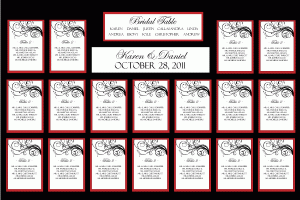Let’s start with … is it a good idea to have assigned guest seating or not?
We say definitely yes!
Here’s why:
First of all, assigned guest seating is a great way to ensure that the people who are dearest to you are seated close to you, while the people you really don’t know as well (like your parents’ friends), are seated further away. You can also group together people who you think will enjoy each other’s fellowship, or create new opportunities for the two sides of the family at the table to get to know one another better.
Need another great reason to avoid open or “guess” seating? Consider the music volume. If you think back to other weddings you’ve attended, you’ll probably agree that the younger people like to hang out in the back of the room. The older relatives want to sit right by the dance floor to watch. We get both concepts, but in reality, it just doesn’t work. The young people are in the back of the room saying, “Hey, turn it up,” while the older people are right next to the dance floor saying, “Hey, turn it down.” We’ve even seen people with a baby seat themselves in a location right next to a speaker, and after having been politely told that they may want to consider sitting somewhere else, simply say, “You just have to turn it down.”
For some background, let’s just go back to those physics lessons we learned as a child. Sound originates at the source and dissipates with distance. When guests insist that the sound should be turned down, because they sat at the table close to the speaker, they will complain. If your head table is further away, you will not be able to hear it, either if we turned it down. With assigned seating, you can avoid the conflicts. Seat your younger friends in the area by the speakers, they do not mind it and usually do not complain. At Class Act, our top-of-the-line sound system uses four speakers so we can distribute the sound better and don’t have to play it as loud.

So, what’s the best way to do assigned seating?
We suggest just picking the table for each guest, and then letting them select their specific seat at the table themselves. You never know what family dynamics may be taking place or what new friendships are developing, so let them take their course.
There are generally two systems you can use: the place card method or the seating chart. Both have advantages and disadvantages, but here are our insider insights and tips for doing things right with each:
Place card method:
• Many people have trouble remembering a new person’s name, so using place cards at the table can be a real advantage if you’re seating people who may not know each other together.
• Place cards also can be used to let the servers know each guest’s dinner choice if it’s a plated dinner. Obviously, this is not as important if you’re having a buffet-style dinner.
• The biggest mistake most people make is the method they use for distributing place cards to their guests. Do not place guest names by a table number in the entryway where they have to stand in line to read ALL the place cards to find their table. Likewise, do not put them on the dining tables ahead of time so that they have to go to each table and read the place cards, and don’t just put them on a table with single side access.
• The best method: Arrange the place cards in alphabetical order and create access from both sides of the table. Put last names A-L on one side and M-Z on the other.


Seating chart method:
• Don’t list your guests by showing a diagram of the tables and their name on a table. They have to read all the tables to find their name.
• The best method: List guest names alphabetically and simply have a table number behind their name — fast and easy.
• Be sure to have a table number visible on each table.


Here are some great insider ideas:
• What if your confirmed number of guests does not evenly fill tables of eight, and would leave the final two guests alone at a table? Instead, make a table of eight and then just put one open seat at each of six other tables. The “surprise guests” can sit at a table where they know some people, or you have an open place at these tables to come visit.
• Have your family seated close to you not only because you love them, but also because they can help you with needs as they come up.
• Seat your older relatives as far away from the dance floor as possible so that they can visit.
• Seat your friends close to the dance floor so that they can leave their drinks on the table and not spill them on the dance floor. You’ll want to take those shoes off later in the night, as you know your girlfriends are the ones who are going to get the party started!
Plan for success with Class Act.


Sorry, comments are closed for this post.